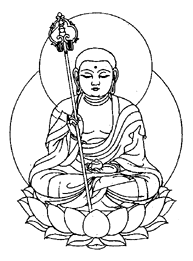|
Back | Home |Next
Description Of Form
He appears gentle with a shaven head, and is depicted as a sravaka
disciple, that is, a monk who has left his home. In his right
hand Jizô holds a shakujô stick with six rings and by shaking
this he awakens us from our deluded dreams. In his left hand he
holds a mani jewel, which signifies that he bestows treasures
and wealth on all beings.
Purpose and Vow
There are very few Buddhist deities which are as popular as Jizô
in Japan. Anywhere one travels in Japan, one sees his smiling
face on the roadside, at crossroads, on high mountains passes
or at the entrance to old graveyards, the six forms of Ksitigarbha
(Jizô) are enshrined. The six forms of Jizô are each responsible
for the Six Paths of Transmigration : hells, hungry ghosts, beasts, demons, human beings, and heavenly
beings. They all vow to save people from sufferings and disasters.The
vows and protective amulets of Ksitigarbha (Jizô) Bodhisattva
lend power to those who are weak, such as children who are caught
between the worlds of life and death, are in dangerous places,
or are in desolate spots.
In Shingon Buddhism, the Sanskrit letter Ais written above the posthumous Buddhist name on the memorial
tablet of an adult who has died, but when young children die,
the Sanskrit letter Ka, which stands for Ksitigarbha, is written. This signifies that
the powerless child is saved and is enabled to become a buddha.
Ksitigarbha Bodhisattva does not get angry or give up even though
he may be trampled upon and stepped on as if he were the earth.
He is a Bodhisattva who has an inexhaustible store of power to
nurture and save all beings with a mind of great compassion.
Mantra
On kakaka bisanmaei sowaka (Jpn.)
Om ha-ha-ha vismaye svâhâ (Skt.)
Om Oh, Wondrous One svâhâ
  
Back | Home |Next
©1998 Shingon Buddhist International Institute
Deity line-art © Dashin Art, Inc. Used with Permission
|

